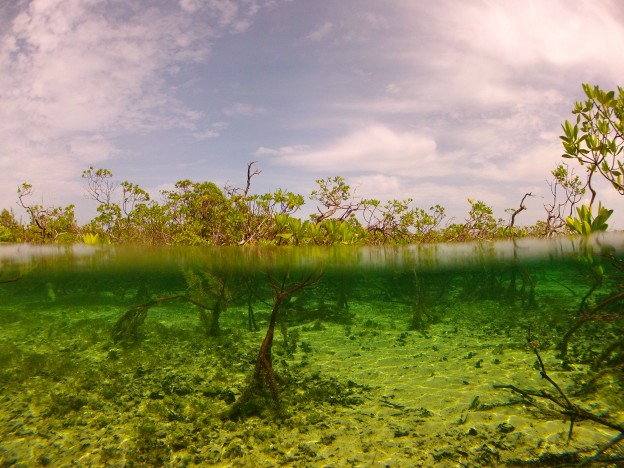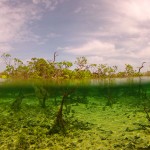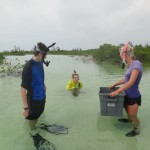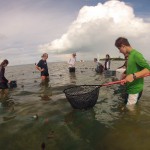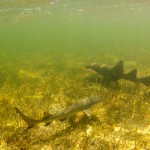September 11, 2013: On a Wednesday afternoon, The Flats research group, consisting of Charlie, Dale, Andrew, Cam, Krissy, Haeyeon and Nani went on an exciting expedition to Paige Creek. There, we snorkeled amidst the mangroves with the inwards current and the rising tide, to do an analysis of the species in 50 meter areas. We conducted a rapid ecological assessment (REA) which consisted of taking the pH, salinity, dissolved oxygen, and temperature of the water, at different places in the creek, as well as noting the different type of species that called this area home. Snorkeling along, we came face to face with Yellowtail and Schoolmaster Snappers, juvenile Sergeant Majors, Red, Black, and White Mangroves, Turtle Grass, and many more species of algae, fish, and plants.
After conducting three REA surveys in various sections of the creek, we returned to the “base camp” we set at the mouth of the river. From there, the group split into two with Dale, Cam, Andrew, and Nani staying at the mouth of the river to test their fishing skills and hand catch some Schoolmaster Snappers to bring back to the wetlabs. At the same time Krissy, Haeyeon, and Charlie got onto the boat with Aaron, and went to check out a nearby reef patch. There, it was primarily made of Rose Coral with a lot of Mustard Hill Coral. There were hundreds of Schoolmaster and Yellowtail Snappers, as well as many Sergeant Majors. This awe-striking reef was incredible to see, with all the diversity living in such a small, shallow pocket of the ocean, with no Network Algae growing on it. Back at the mouth of the river, when we returned, nobody had caught any fish, even fishing master Dale hadn’t been able to get anything due to the fact that we were just using lines with a hook. But against all odds, as we were about to leave, Cam caught one Schoolmaster Snapper, and allowed us to go home not totally defeated in the fish catching aspect of our trip.
September 18, 2013: It was 4:20 at low tide and on the count of three, armed with flailing nets and kicking feet, our army of young researchers stampeded through the fish infested flats. Between the open ocean and the mouth of the creek, lay a 100 meter net which would engulf the schools of frightened fish. Six Lemon Sharks, one giant Bonefish, countless Mojarras and Schoolmaster Snappers were caught in a panicked frenzy as the net trapped them from all sides. Immediately, Nani and Krissy ran to shore to grab some containers as Dale, Hayeon, Cam, Charlie, and Andrew began to sort out the captives one by one. Some of these fish were destined to be brought back to the lab for future experimentation, while others, like the sharks, were tagged and measured before being released back into the ocean. Everyone received a chance to touch, measure, record data, and tag the feisty, juvenile Lemon Sharks, an experience we are sure not to forget.
This field day was dedicated to capturing twenty Mojarras and Schoolmaster Snappers as well as two Lemon Sharks. We needed these fish for our wet lab experiments, which are geared towards studying the effects of climate change on our mangrove inhabitants. Wading around in the water, we could feel the stinging warmth of the shallow salt water and could only imagine how toasty it must feel for our ectothermic friends. The more we get to know about the habitat we are studying, the more we anticipate being able to contribute to their preservation.

